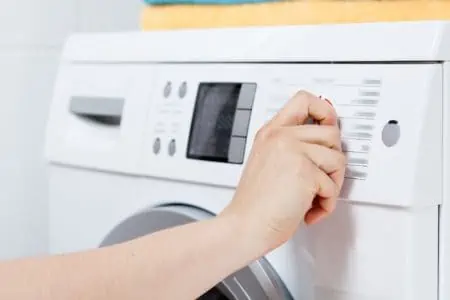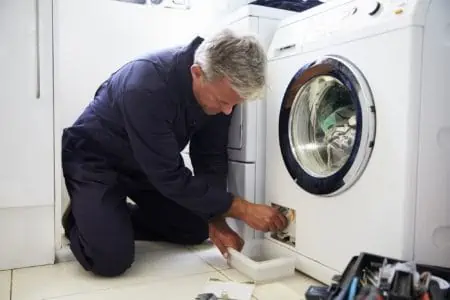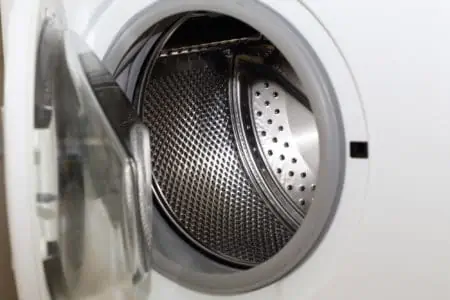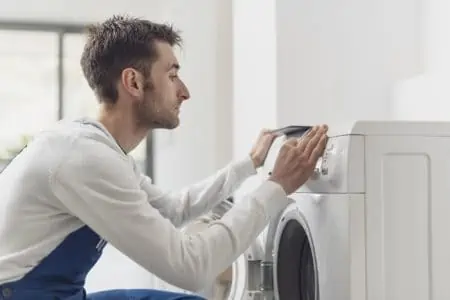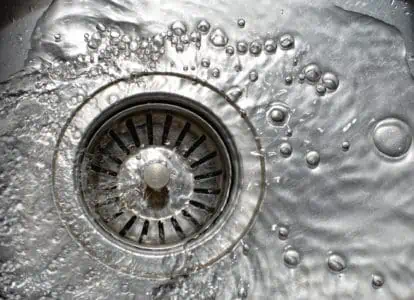It can be very frustrating when all you want to do is run a washing cycle but instead your washing machine keeps flashing fault codes at you. You worry about high repair costs or needing to replace your washing machine. Thankfully, many of the Kenmore washing machine error codes have simple solutions.
You will be able to resolve these issues once you know what the problem is and how to fix it.
Key Takeaways
- Common Kenmore washer error codes include LF (Long Fill), Ld (Long Drain), uL (Unbalanced Load), and oL (Overload).
- LF error can be fixed by checking intake hoses for kinks or damage, and ensuring water intake screens are clear.
- Ld error can be resolved by inspecting the drain hose for clogs and ensuring the drain pump is functioning properly.
- uL error requires redistributing laundry in the drum to balance the load, while oL error means removing some laundry to reduce the load size.
How Do I Read the Error Code on My Kenmore Washer
Kenmore washer codes give a quick diagnostic of what is wrong with your washer no matter whether it’s an HE2 or HE3 front load washer or a simple top load machine. This gives you an idea of what is wrong and how to fix it.
What Does Code F Mean on Kenmore Washer?
The F error code means that the washing machine has discovered a problem with one of the parts of your machine. We will explore this in more detail for each type of F error code.
Kenmore Washer Error Codes
These are some of the common Kenmore washer error codes that you may see as you use your Kenmore washing machine. You’ll learn what they mean and how to fix the issues.
LF
Long Fill: The washing machine is taking too long to fill.
How to Fix: Check to see if the intake hoses are kinked or damaged. If the hoses are kinked, straighten them. Damaged hoses will need to be replaced. Also look at the water intake screens and make sure that they are clear. Once you’ve checked the intake hoses and screens press the STOP button to clear the display.
Ld, F02, or F21
Long Drain: Your washer is taking too long to drain.
How to Fix: Check the drain hose to make sure that it’s properly installed. Then check to see if it’s kinked or clogged. Straighten the hose or remove the clog to allow the washer to drain properly.
uL
Unbalanced Load: The load is unbalanced. The washer will first run a recovery routine. If this does not work, the machine will stop.
How to Fix: Once the washer has stopped, open the lid to redistribute the laundry inside the machine. The weight will need to be evenly distributed around the drum. You can prevent an unbalanced load from happening by washing smaller loads. Also, avoid washing very heavy items.
oL
Overload: The load of laundry is too large.
How to Fix: Open your washing machine. Remove several items of laundry to reduce the amount of material in your machine. Then add detergent and restart the wash cycle.
Sd
Suds Detected: Your washer has detected too many suds in your machine. A suds reduction cycle will be run after the cycle to remove the suds from your clothing. If you discover the Sd error flashing and the machine has stopped, run a second wash cycle without detergent to rinse the excess suds from your laundry.
How to Fix: Prevent the error from occurring by only using HE laundry detergent in your machine. Be careful to use the correct amount of detergent as too much detergent will cause excessive sudsing.
lid
Lid Isn’t Closed: The lid isn’t closed when you press the START button. The error may also appear if you started more than 2 wash cycles without opening the lid.
How to Fix: Close the lid. If the lid is closed, then open and close the lid. If the lid lock/switch sensor is not sensing the lid opening and closing, then you may need to replace it.
dL
Door Isn’t Locking: The door of your washing machine is unable to lock.
How to Fix: Make sure that nothing is preventing the door from closing. Then dip a cotton swab into rubbing alcohol to clean the lock sensors. Sometimes the sensors become dirty which prevents them from sensing when the door is closed. Next, press STOP to clear the code from the display.
dU or F29
Door Lid Can’t Unlock: The door lid is unable to unlock.
How to Fix: Make sure that nothing is on the lid of your washing machine such as a basket. Too much weight will prevent the door lid from unlocking. If this doesn’t work, try unplugging your washing machine for a few minutes to reset the central control unit. The door latch mechanism may need to be replaced.
FL or F27
Flood Error: There is a high level of water inside your washing machine.
How to Fix: Check the drain pump to make sure that it’s not clogged and working properly. Remove any clogs found. You may need to replace the drain pump if it’s not working. Another reason could be that a water intake valve may have failed, so you may need to replace the faulty valve.
Er
Processor Reset Error: The power failed during a wash cycle, and the cycle information was not saved.
How to Fix: Press the STOP/CANCEL button to clear the display.
CE
Communication Error: Your machine is having a communication error between the machine controller and the motor controller.
How to Fix: Press the STOP/CANCEL button to clear the display. If you receive the error again, check to make sure that the connections are secure. Otherwise, you may need to replace the motor controller.
CA or Cl
Current Limit: The washing machine may be overloaded.
How to Fix: Remove some articles from the washer to decrease the load size. Press the STOP/CANCEL button to clear the display.
Or
Open Relay: Your washer experienced an operation failure.
How to Fix: This type of error needs a professional so call a technician to service your machine.
Sr
Stuck Relay: Your washing machine experienced an operation error.
How to Fix: This repair requires a technician to repair your machine.
LS or F26
Lid Switch Error: The lid or door switch is experiencing a problem.
How to Fix: If the lid is open, close the lid and press the START button. Open and close your lid if it’s closed. Also, dip a cotton swab into rubbing alcohol to clean the lid switch sensors if they’re dirty.
SU
Suds Lock: Too many suds are detected.
How to Fix: Press the STOP/CANCEL button to clear the display. Turn the machine to the drain/spin cycle to remove all of the water. Then, start a new wash cycle with cold water to rinse the excess suds from your washing machine. Do not add any detergent to this cycle.
dt
Diagnostic Tests: This is for service diagnostics only.
How to Fix: Press the STOP/CANCEL button to clear the display. If it shows up again, you may need to call a technician.
ob
Off-Balance: Your washer is off balance.
How to Fix: Redistribute the load as needed to balance it correctly. Then close the lid and press the START button to restart the cycle.
rL
Load Inside Drum: You started the clean washer cycle, but articles of laundry have been detected inside the drum.
How to Fix: Remove the articles of laundry and press the START button.
DE or F22
Door Lock Error: The door locking mechanism is experiencing an error.
How to Fix: Check the door latch and the door switch assembly along with the door lock sensor to see if there’s an error. If so, replace that part.
LE
Washer Has Locked Up: The washing machine has locked up and is unable to run for some reason.
How to Fix: First, see if you have added too large of a load to your washer that has caused it to lock up. If so, remove some of the articles in the drum. Next, see if there are excessive suds in the machine. Wait 30 minutes for the suds to dissipate. Then run the drain/spin cycle to remove the water. Follow up by running a cold water wash cycle without any detergent to rinse the excessive suds away. Make sure that you only use the correct amount of HE detergent in the future.Otherwise, you may have a drive system obstruction, loose wiring, or a defective motor. Call a technician to diagnose your washing machine.
drn
Drain Error: Your washing machine is experiencing a drain error.
How to Fix: Fix the drain error by checking to see whether there’s a clog or a kink in the drain pipe. Remove the clog or kink if you find it. Also, check to make sure that the drain pump is working properly. It may have a clog or may be malfunctioning. If it’s a clog, remove it. Otherwise, you may need to replace the drain pump.
FH
Washer Isn’t Filling: Water has not been detected entering the washer.
How to Fix: Make sure that the water intake valves are turned on. Check to make sure that the water intake screens are not clogged. Remove the clog if it’s there. Plus, make sure that the intake hoses are not kinked or damaged. Straighten kinked intake hoses and replace damaged hoses. If these solutions don’t help, you may need to call a technician to troubleshoot your washer.
F01
Potential Error with the CCU Board: There may be a communication problem between the central control unit and the EEPROM unit. The F01 error may also be caused by the drain pump not starting or the main relay error.
How to Fix: An issue with the power may have caused the error. First, unplug the washing machine for two minutes then verify that the central control unit is working by entering a diagnostic mode or starting a wash cycle. If this doesn’t work, call a technician as the CCU board may be malfunctioning.
F06 or F25
Drive Motor Tachometer Error: This error is most often caused by the drive motor, motor control board, or the wire harness.
How to Fix: Sometimes the error is a result of overloading your washing machine. Try washing smaller loads. If the error reoccurs, check your manual and call a technician.
F11
Motor Control Unit Error: The motor unit has an internal error.
How to Fix: Unplug the washing machine. Check the wire harness connections between the drive motor and the motor control unit. Also, check the connection between the motor control unit and the central control unit. Follow this by checking the motor and running a continuity test. You may need to replace the motor control unit.
F20
No Water Detected: Water was not detected entering the washing machine. There may be an issue with the intake valves or with the pressure switch.
How to Fix: First, make sure that the water intake valves are working properly. Then check the intake hoses for kinks or damage. If you find damage, the hose will need to be replaced.
F23
Heater Failure: The water temperature in the washing machine is less than 86 degrees Fahrenheit or 30 degrees Celsius after 40 minutes.
How to Fix: Unplug your washing machine. Make sure that the water heater is connected properly. Then check the resistance of the heating element. Finally, make sure that the water sensor is connected and working properly.
F24
Water Temperature Sensor Error: The water temperature that the sensor is reading is out of the normal range.
How to Fix: Unplug your washing machine to make sure that the sensor is connected and working. Then double-check the resistance of the heating element with a multimeter.
F28
Serial Communication Error: The central control unit and the motor control unit are not communicating.
How to Fix: Unplug the washing machine to check the wire harness connections between the CCU and MCU. Look for worn or damaged components as well. Then plug your washer into the electrical socket. You may need to call a technician for further diagnosis and troubleshooting.
F30
Dispenser Motor Error: The dispenser motor is unable to go to its proper position.
How to Fix: Unplug your machine to check to make sure the dispenser’s wire connections are connected. Also, check the mechanical link between the dispenser to the dispenser’s motor. You will also need to ensure that the dispenser motor can make powered rotations.
F31
MCU Failure: The heat sink became too hot, so the motor control unit stopped the machine. If this issue happens 4 times, then the F31 error will show.
How to Fix: Unplug the machine to check the wire harnesses for a strong connection between the MCU, motor, and central control unit. Look at the drive system to make sure that there are no worn or damaged parts. Plugin the washer and check the MCU for drive motor operations. Check the drive motor for rotations.
F33
Pump Drive System Error: The pump drive and the central control unit have lost communication.
How to Fix: Disconnect the washer. Check the wire harnesses to make sure there’s a good connection between the pump drive and CCU. Plugin the washer and run a diagnostic to make sure that the CCU is working.
How Do I Reset My Kenmore Elite Washer?
The Kenmore washing machine does not have a reset button. Remove your machine from the power supply for 5-10 minutes to reset the washer by unplugging your machine or turning off the power at the breaker switch.
Wait the 5-10 minutes needed for all the electrical charge to leave your washing machine. Plug your washing machine into the electric socket again or turn the power on at the breaker switch.
How Do You Bypass the Lid Lock on a Kenmore Washer?
Turn off your washing machine and unplug it before you begin. Then locate the two screws holding the top horizontal panel down. They may be behind the plastic shields along the side of the horizontal panel.
Remove the horizontal panel carefully. You will find the lid lock switch underneath the panel. Replace the top horizontal panel on your washing machine and screw in the two screws to hold it in place.
FAQs
